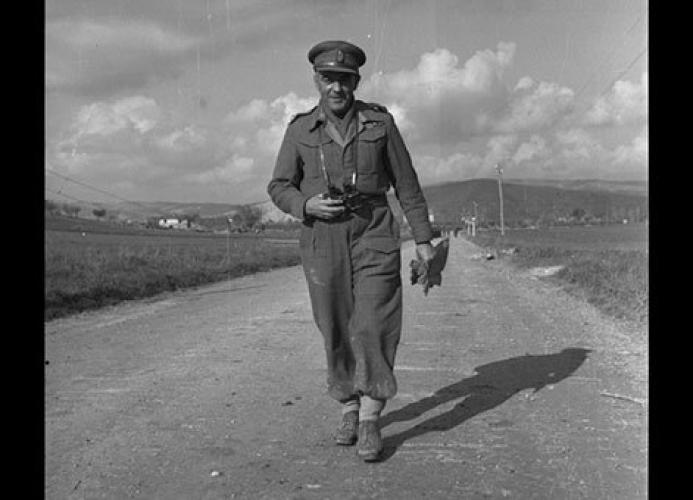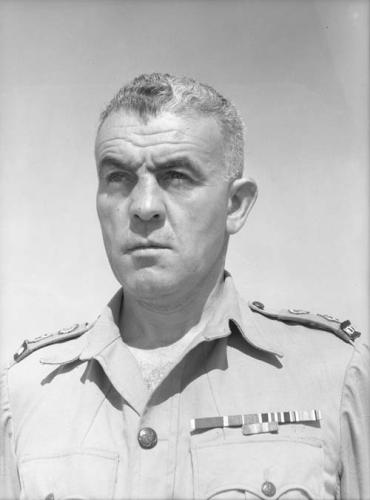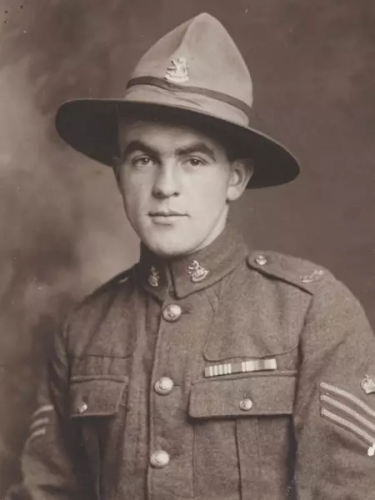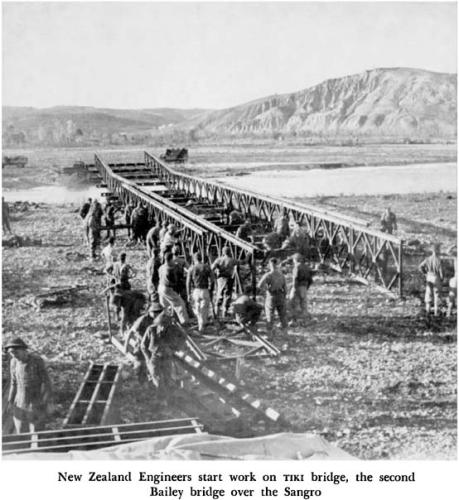Brig F H Hanson then Lt Col NZE 1943
Reason for the name
Brigadier Frederick (“Bull”) Melrose Horowhenua Hanson CMG, DSO, OBE and Bar and MM (9 July 1895 – 15 July 1979) was a New Zealand soldier, engineer, military leader and public servant.
Born in 1895, Brigadier Hanson joined the New Zealand Expeditionary Force (NZEF) during WW1 and served on the Western Front. By wars end he had reached the rank of sergeant and been awarded the Military Medal.
Between wars, he worked for the Public Works Department on hydroelectric projects and public roading.
During WW2, he served with the 2nd New Zealand Division first as the Officer Commanding 7 Field Company eventually becoming Commander Royal Engineers (CRE) of the New Zealand Engineers of the NZEF and served in Greece, Crete, North Africa and Italy.
He received official recognition for his efforts in the war, receiving the Distinguished Service Order and bar and was appointed an Officer of the Order of the British Empire.
Ending the war with the rank of brigadier, he returned to civilian life as the chief engineer of the Main Highways Board. He was later appointed the Commissioner of Works, the senior position at the Ministry of Works and responsible for 4,500 employees. Retiring from public service in 1961, he died in 1979 at the age of 84.
His Story
Frederick Melrose Horowhenua Hanson was born in Levin on 9 July 1895, the son of Eliza Elizabeth Tantrum and her husband, Frederick Hanson, a farmer. He spent two years at Levin District High School before winning an education board scholarship to Wellington College. There he won several prizes, qualified for matriculation in 1912 and then stayed on to study for the civil service examinations. He played a very active part in college life, becoming captain of the rugby First XV and head prefect. Hanson was also a successful boxer and excelled in the school’s cadet unit. He was commissioned as a second lieutenant on the Territorial Force’s unattached list in 1914.
Hanson had been considering a military or an engineering career and in early 1915 successfully applied for one of the New Zealand places at the Royal Military College of Australia at Duntroon, falsifying his age to gain admission. He performed successfully at Duntroon, but in October 1917 was expelled for misconduct.
As soon as he returned to Wellington, Hanson enlisted in the New Zealand Expeditionary Force. He served with the Wellington Infantry Regiment on the western front during the final year of the First World War and rose to the rank of sergeant. For his ‘conspicuous gallantry and devotion to duty’ during an action in September 1918 he was awarded the Military Medal. Before returning to New Zealand in September 1919 he played in the NZEF rugby team which toured the United Kingdom and France. Late in 1919 he was promoted to lieutenant in the Territorial Force. Until early 1922, when he transferred to the reserve of officers, Hanson served with cadet units. He was posted to the retired list in 1930.
After he returned to New Zealand Hanson qualified as a surveyor. In 1921 he joined the Public Works Department, working on hydroelectric projects and then in the Wellington district office. Hanson married Margaret Constance Grindley on 23 December 1924 at St Paul’s Cathedral Church, Wellington. In 1935 he developed the low-cost system for chip-sealing roads which is now used throughout New Zealand and elsewhere in the world. Between 1936 and 1939 he was the Main Highways Board’s resident engineer.
When the Second New Zealand Expeditionary Force (2NZEF) was being formed in 1939 Hanson was regarded as a very capable engineer whose military experience and training, and strong personality, would make him a good engineer company commander. In May 1940 he was given command of the 7th Field Company, New Zealand Engineers, with the rank of major. ‘Bull’ Hanson, as he was known, emerged as an outstanding engineer officer who combined technical expertise and personal bravery with leadership skills. He was a tough, ‘solid block of a man with greying, crinkled hair and a lined open face’ who knew how to get the best out of the hard-bitten New Zealand sappers. During the Greek campaign he pioneered the technique of laying mines around bridges and other key points that had been destroyed, in order to delay the German advance. On Crete he performed capably when he was temporarily made the New Zealand Division’s commander, Royal Engineers (CRE). He joined in the ferocious impromptu counter-attack at a sunken road called 42nd Street after one of his men called out, ‘Come on Boss, let’s be in’.
In October 1941 Hanson was promoted to lieutenant colonel and appointed CRE of the New Zealand Division. His contribution to the division’s operations was recognised the following year when he was appointed an OBE. During the pursuit of the Axis forces across North Africa during 1942–43 he personally reconnoitered the routes to be taken by the New Zealand Division in operations to outflank enemy positions. For his bravery and leadership during the attack on the Wadi Akarit position in April 1943 he was made a DSO; he was also mentioned in dispatches. He was given the additional post of chief engineer 2NZEF in September 1943 and promoted to colonel.
In Italy the New Zealand Engineers and their commander further enhanced their reputation in a campaign that was in many respects an engineers’ war. Hanson was primarily responsible for the development of the innovative bridging techniques that helped the New Zealand Division spearhead the Allied advance across north-eastern Italy in 1945. His work during this offensive was rewarded with a bar to the DSO. Hanson was wounded three times during the war and temporarily held the rank of brigadier on three occasions. He returned to New Zealand, was discharged from 2NZEF early in 1946, and was posted to the reserve of officers with the rank of brigadier.
Hanson was then appointed chief engineer of the Main Highways Board. He played a major part in formulating the National Roads Act 1953, which replaced the highways board with the National Roads Board, and served as the new body’s first chairman. In 1951 he was appointed deputy commissioner of works; four years later he was made commissioner of works. At this time the Ministry of Works employed nearly 4,500 people and was one of the largest and most powerful government departments. Under his forceful leadership the ministry had a central role in the government’s national development strategy and was involved in a vast range of activities, including major projects such as the Benmore hydroelectric scheme. Hanson was an associate member of the Army Board between 1952 and 1955. During 1955–56 he was president of the New Zealand Institution of Engineers. Shortly before he retired in December 1961 he was made a CMG. He died at Wellington Hospital on 15 July 1979, survived by his wife; they had no children.
Frederick Hanson was an intelligent, vigorous man with abundant energy and initiative, who in both his civil and military careers had a reputation for fearlessly putting forward his views. His bravery, technical and organisational skills and leadership qualities brought him distinction as a soldier and as a public servant.
His Decorations
Companion of the Most Distinguished Order of St Michael and St George (CMG) AWMM
Companion of the Distinguished Service Order and bar (DSO*) AWMM
DSO: NZ Gazette, 21 September 1944. Citation: "At the Wadi Akarit position on the morning of 6th April 1943, Lieutenant Colonel Hanson was placed in command of a party of tanks, infantry and engineers. Their task was to make two gaps in the enemy minefield after the infantry had passed through and formed a bridgehead. The infantry attack was held up and the minefield covered by enemy small arms and artillery fire. Although the infantry was still pinned to the ground, this officer led forward the tanks to the edge of the minefield and organised his force so that engineers could commence work on clearing the gap. Working himself with the engineers, under considerable fire, he succeeded in directing his force in such a manner that the engineers were enabled to clear the necessary gaps for the tanks to go through and engage the enemy. By his fine example of leadership and disregard for personal safety he enabled an enemy position to be taken which appeared as though it would hold out all day and seriously prejudice the Corps plan. Throughout the campaign the work of this officer has been of the highest order."
DSO Bar: NZ Gazette, 30 April 1946.
Citation: "For outstanding devotion to duty and great personal gallantry as C.R.E. from the battle of the Senio River to the entry of the New Zealand Division into Trieste. Colonel Hanson throughout the campaign displayed skill of the highest order in planning and carrying out a long series of bridging operations across the Rivers Senio, Santerno, Sillaro, Gaiana, Idice, Reno, Po, Adige and Piave, together with the erection of numerous other bridges over the minor water obstacles which lay between these bigger rivers. The great speed and efficiency with which many rivers and difficulties were overcome, and Bailey bridges, pontoon bridges, and Class 40 rafts were put into operation was largely due to his personal reconnaissance’s and subsequent control of operations. This work he carried out on many occasions under heavy fire, and his personal courage and resolution were a great inspiration to his men, in carrying on his work in the most trying and exhausting of circumstances. The speed with which Colonel Hanson and the Divisional Engineers under his command performed their work enabled immediate exploitation of all bridgeheads and thus prevented the enemy from re-occupying each successive river line. Their work made possible the rapid advance of the Division."
Military Medal (MM)
"Awarded for gallantry in handling a Lewis gun and keeping off repeated enemy attacks on an exposed flank near Havrincourt Wood (France) about 14 September 1918".
Commanders, New Zealand Engineers, 2 NZEF
Lt-Col F. P. Heath 27 Sep 1939–11 Aug 1940
Lt-Col L. F. Rudd 11 Aug 1940–5 Sep 1940
Lt-Col G. H. Clifton 5 Sep 1940–18 Oct 1941
Lt-Col F. M. H. Hanson 18 Oct 1941–2 Sep 1942
Lt-Col J. N. Anderson 2 Sep 1942–1 Oct 1942
Lt-Col F. M. H. Hanson 1 Oct 1942–11 Apr 1944*
Lt-Col J. N. Anderson 11 Apr 1944–23 Jul 1944
Lt-Col R. C. Pemberton 23 Jul 1944–30 Aug 1944
Lt-Col J. N. Anderson 30 Aug 1944–12 Nov 1944
Col F. M. H. Hanson 12 Nov 1944–6 Jan 1945
Lt-Col C. Clark 6 Jan 1945–2 Feb 1945
Col F. M. H. Hanson 2 Feb 1945–15 Jan 1946
* Promoted Colonel 17 Sep 1943, when he was appointed Chief Engineer, 2 NZEF, in addition to Commander Royal Engineers (CRE) 2 NZ Division. From 9 February to 27 March 1944 he was Chief Engineer, NZ Corps, with the temporary rank of Brigadier. He held the same rank from 6 January to 2 February 1945 while serving as Chief Engineer, 5 Corps.









